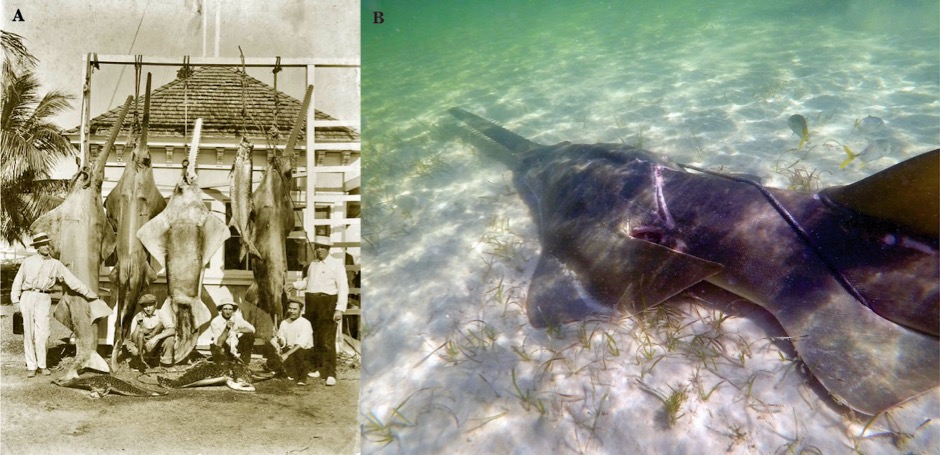MIAMI—A new collaborative study lead by scientists at the University of Miami (UM) Rosenstiel School of Marine and Atmospheric Science and the National Oceanic and Atmospheric Administration (NOAA) found evidence of growing numbers of critically endangered smalltooth sawfish within coastal waters off Miami, Florida, an area where the regular presence of this rare species had gone largely undocumented, until now. The new findings are part of a NOAA initiative to support and enhance the recovery of smalltooth sawfish in and around Biscayne Bay, a coastal lagoon off Miami, that was designated a Habitat Focus Area by NOAA in 2015.
A shark-like ray, smalltooth sawfish (Pristis pectinata) are unique for their long flat rostra with roughly 22-29 teeth on either side that is used to detect and catch prey. The species can reach 16-feet in length. NOAA estimates that smalltooth sawfish populations in U.S. waters have declined by as much as 95 percent from a combination of overfishing, bycatch in fishing gear, and habitat loss from increasing coastal development.
The research team compiled sighting records dating as far back as 1895 and recent encounters of sawfish in the Biscayne Bay Habitat Focus Area.
“Our analysis showed sightings have increased exponentially in recent decades, with some individuals even appearing to be making returning annual visits,” said Laura McDonnell, the study’s lead author and a PhD student at UM Abess Center for Ecosystem Science & Policy and researcher at the UM Rosenstiel School. “These findings demonstrate that smalltooth sawfish have been using these waters with some regularity, largely unnoticed prior to the compilation of these records.
“However, the extent to which sawfish use Biscayne Bay and reason for their occurrence remains unknown,” said Joan Browder, a fisheries biologist at NOAA’s Southeast Fisheries Science Center and senior author of the study. “Understanding this would be a valuable next research step.”
Many of the smalltooth sawfish documented in this study were found in waters very close to Miami, where they were exposed to high levels of pollution, boat traffic, and fishing.
“These results highlight a need to understand the effects of coastal urbanization on smalltooth sawfish and the conservation implications for this and other endangered species using the area,” said Neil Hammerschlag, research associate professor at the UM Rosenstiel School and UM Abess Center for Ecosystem Science & Policy and co-author of the study.
“Given the documented use of smalltooth sawfish in and around Biscayne Bay, we hope the area will receive informative signage to help inform the public about their endangered status, the importance of reporting encounters, and the dangers of harming sawfish,” said McDonnell.
The researchers urge citizens to report smalltooth sawfish sighting in South Florida waters to 1-844-4-SAWFISH (1-844-472-9347).
The study, titled “Saws and the city: smalltooth sawfish (Pristis pectinata) encounters, recovery potential and research priorities in urbanized coastal waters off Miami, Florida,” was published on December 17, 2020 in the journal Endangered Species Research
The study’s authors include: Neil Hammerschlag and Laura McDonnell at the UM Rosenstiel School, George H. Burgess at the University of Florida; Lindsay Phenix at Northeastern University and Austin J. Gallagher at Beneath the Waves Inc; Thomas Jackson, Helen Albertson and Joan Browder at NOAA’s Southeast Fisheries Science Center in Miami. The collaborative study was conducted as part of the NOAA Cooperative Biscayne Bay Habitat Focus Area project.
Support for this project was provided by the Save Our Seas Foundation, Ocean Tracking Network and the Disney Conservation Fund, Herbert W. Hoover Foundation, NOAA, and C. and M. Jones.

